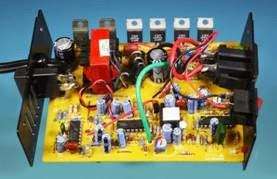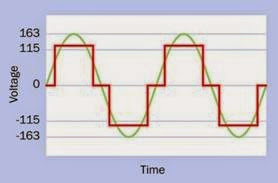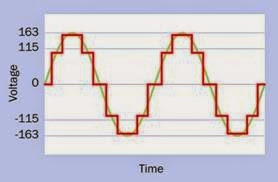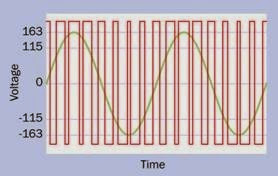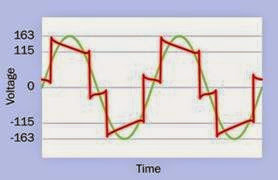A power inverter must not be confused with a logic inverter, which functions as a digital component in logic circuits to invert the state of a low-voltage DC input from high to low or low to high. Logic inverters are discussed in Volume 2.
A power inverter is included here as counter point to a power supply or AC adapter, since it has the opposite function. The inverter receives an input of direct current (typically 12VDC from a car battery) and delivers an output of alternating current (AC) in the range 110VAC-120VAC or 220VAC-240VAC, suitable to power many low- wattage appliances and devices. The interior of a low-cost inverter is shown in Figure 18-1.
Figure 18-1. The interior components in a 175-watt inverter.
How It Works
The first stage of an inverter typically raises a 12VDC input to a higher DC voltage via an internal DC-DC converter, then uses a switching circuit to create an approximation of the sinusoidal profile that is characteristic of AC voltage.
Digital switching components naturally tend to create square waves, whose simple appearance conceals the presence of higher frequencies, or harmonics, that are ignored by some devices (especially those that convert electricity into heat) but can be troublesome in consumer electronics equipment. A primary objective of inverter design is to adapt or combine square waves to emulate a classic AC sine wave with reasonable fidelity. Generally speaking, the more accurately an inverter emulates a sine wave, the more ex pensive it tends to be.
The most primitive inverter would create a plain square wave such as that shown in red in Figure 18-2, superimposed on a comparable sine wave (in green). Note that alternating current rated at 115 volts actually peaks at around 163 volts because the number 115 is the approximate root mean square (RMS) of all the voltage values during a single positive cycle. In other words, if the voltage is sampled x times during a cycle, an
RMS value can be derived by squaring each sample, adding all the samples, dividing by x, and then taking the square root of the result. The RMS value is important as a means to calculate actual power delivered because it can be multiplied by the current to obtain an approximate value in watts.
Figure 18-2. Comparison of an AC voltage sine wave (green) and a square wave of the same frequency (red), both delivering a roughly similar amount of power.
Variants
As a first step toward a better approximation of a sine wave, gaps of zero voltage can be inserted between square-wave pulses. This “gapped” square wave is shown in Figure 18-3.
Figure 18-3. Introducing pauses or gaps of zero voltage between square-wave pulses can produce slightly improved resemblance to a sine wave.
A further improvement can be achieved if an additional, shorter pulse of higher voltage is added to each primary pulse, as shown in Figure 18-4. Outputs of this kind are referred to as modified sine wave, although they are actually square waves modified to emulate a sine wave. Their in accuracy is expressed as total harmonic distortion (THD). Some authorities estimate that the THD of gapped square-wave output is around 25%, whereas the addition of shorter square waves reduces this to around 6.5%. This is a topic on which few people agree, but there is no doubt that a “stacked” sequence of square waves pro vides a closer emulation of a sine wave.
Figure 18-4. A secondary stream of narrower square- wave pulses can improve the fidelity of an inverter’s out- put.
A true sine wave inverter typically uses pulse-width modulation (PWM) to achieve THD of less than 1%. It generates a stream of pulses much higher in frequency than that of the AC output, and varies their widths in such a way that their aver aged voltage closely approximates the voltage variations in a sine wave. A simplified representation of this principle is shown in Figure 18-5.
Values
Small inverters are typically rated to deliver up to 100 watts and may be fitted with a 12VDC plug for insertion in a vehicle’s cigarette lighter. Since a cheap inverter may be only 80% efficient, 100 watts at 135VAC will entail drawing as much as
Figure 18-5. Pulse-width modulation adjusts the widths of pulses delivered at a high frequency. The pulse widths can be averaged to generate voltage that follows a close approximation of a sine wave.
10 amps at 12VDC. Cigarette lighters are usually fused at 15 or 20 amps, so 100 watts is a reason able value. Inverters that are rated above 150 watts usually have cables terminating in oversize alligator clips for direct connection to the terminals of a 12V battery.
While the cold cranking rating of a car battery may be 100 amps or more, the battery is only designed to deliver that power for up to 30 sec onds at a time. Inverters rated for as much as 500 watts will exceed the normal capacity of a single car battery, although if the battery is mounted in a vehicle, it can be supplemented by running the engine so that the alternator shares some of the load. A 500-watt inverter is better supplied by two or more 12-volt car batteries wired in parallel.
How to Use it
Small inverters are typically used in vehicles to run cellphone chargers, music players, or laptop computers. Large inverters are an integral part of off-the-grid solar and wind-powered systems, where battery power must be converted to AC house current. Uninterruptible power supplies contain batteries and inverters capable of run
ning computer equipment for a brief period. Battery-driven electric vehicles with AC motors use inverters with an exceptionally high current rating.
There is a lack of consensus regarding possible harmful effects of powering electronics equipment with a low-cost modified sine wave inverter. Anecdotal evidence suggests that where the equipment uses its own switching power supply or uses an AC adapter (either mounted internally or as an external plug-in package), the filtering built into the power supply will block harmonics from the inverter.
Other evidence suggests that cheap inverters may have adverse effects on devices containing synchronous motors that run direct from AC. There are reports that fluorescent lighting and photographic electronic flash systems may be unsuitable for use even with modified sine wave inverters. However, differences in product design and component quality make it impossible to generalize. A cheaply made inverter may generate a wave form that is not even a close approximation of a square wave. See Figure 18-6.
Figure 18-6. A cheaply made inverter can generate a distorted wave form that is even higher in noise than a pure square wave. This sample is adapted from an actual oscilloscope trace.
What Can Go Wrong
If multiple batteries are connected in parallel, using suitably heavy-gauge wire to power a large inverter, the batteries must be identical in specification and age, and must all be equally charged to prevent high and potentially dangerous flows of current among the batteries as they attempt to reach an equilibrium among themselves. In terconnections must be firmly clamped to clean battery terminals. For additional information, see the battery entry in this encyclopedia.
Problems associated with inverters are likely to be mundane. A 12V wiring to the inverter can
overheat if items such as clothes or bedding are left on top of it; a high-wattage fan-cooled in verter can overheat if the fan is obstructed by poor placement or impaired by accumulated dirt; alligator clips may become dislodged from battery terminals; and power surges drawn by inductive loads such as motors may trigger the inverter’s breaker, especially if they are used in conjunction with other equipment.
As always, high amperage should be treated with caution and respect, regardless of it being delivered at “only 12 volts.”
